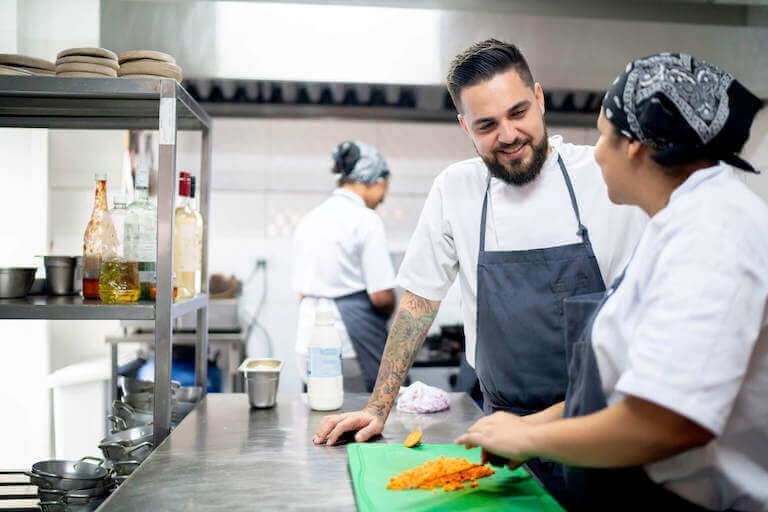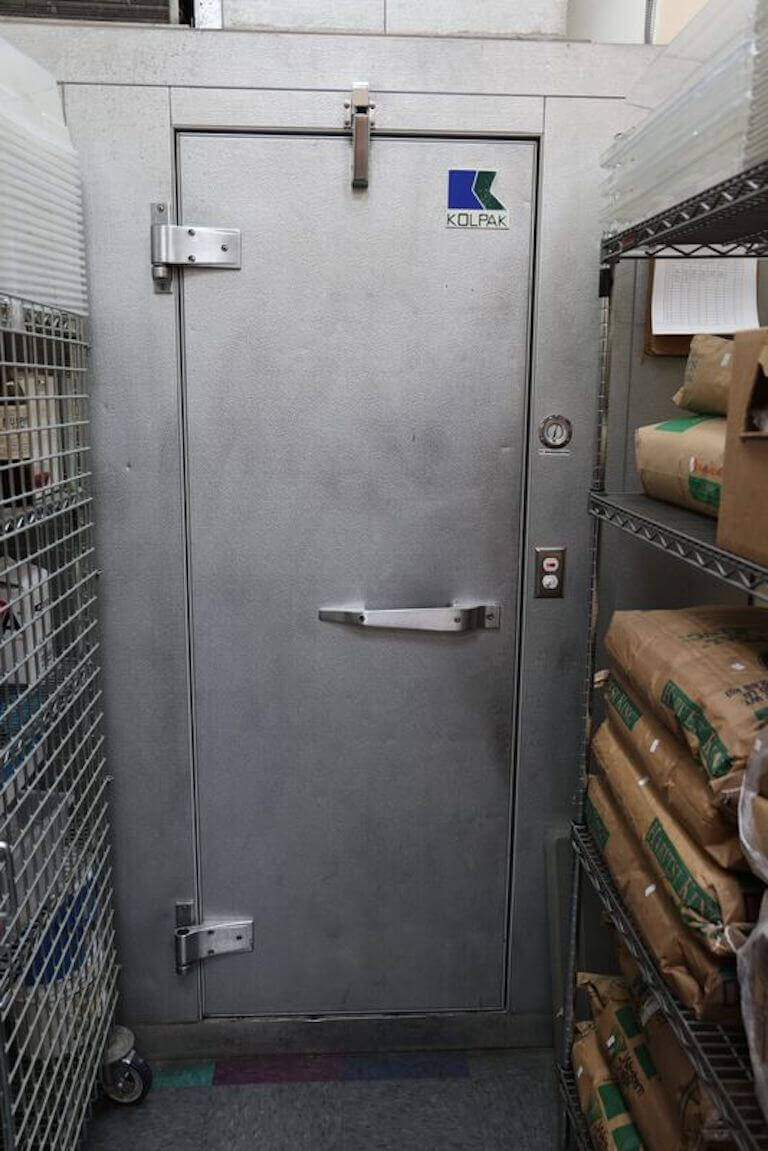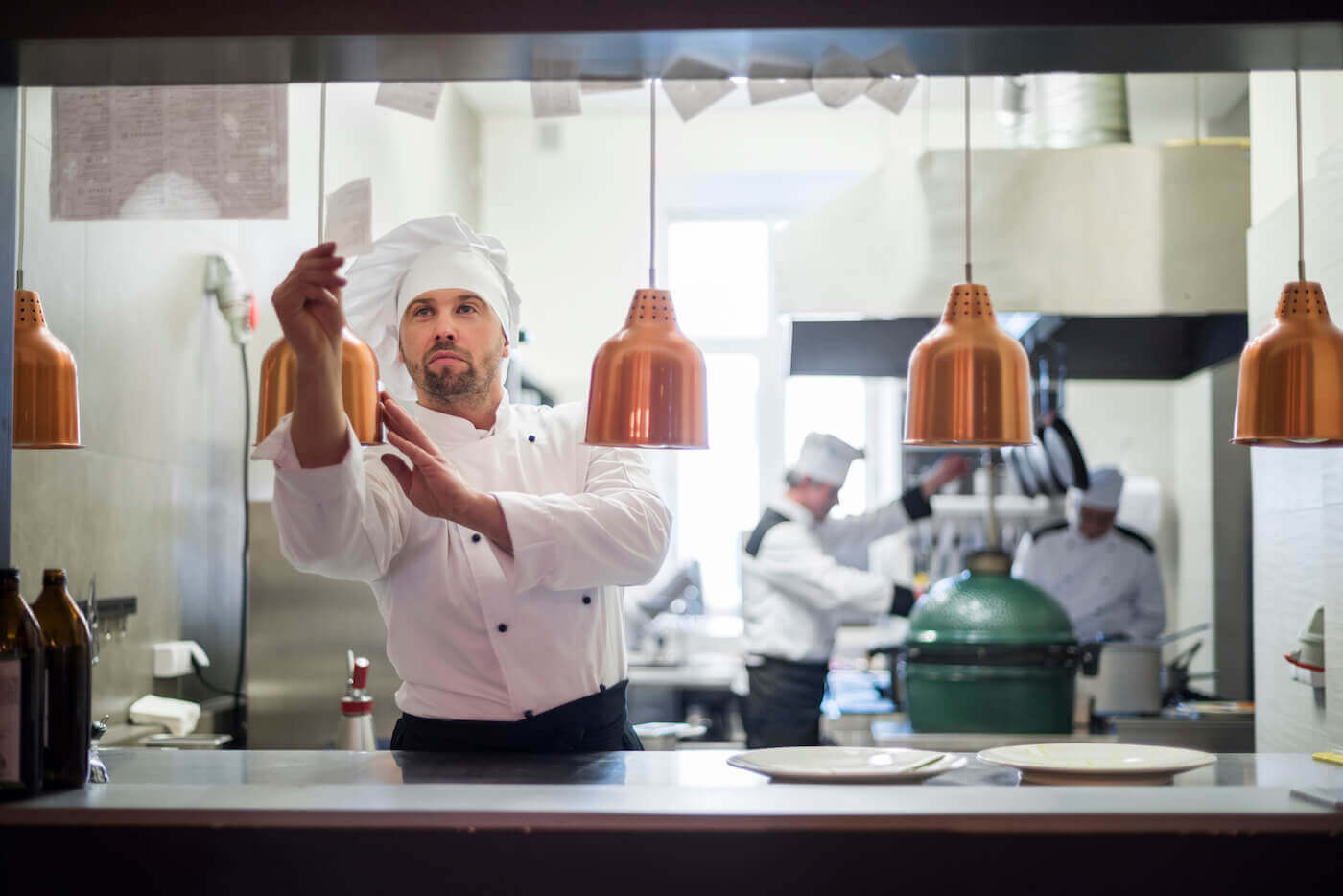Listen to This Article:
No matter the size, kitchens can be chaotic, loud, and fast-paced. Effective communication can make all the difference. It’s the cornerstone of any efficient and successful kitchen—whether there’s a team of two or twenty.
Communicating in the kitchen is unique from other modern workplaces. Chefs and cooks must be able to share important information to succeed in service and create a strong team that pulls together, without relying on meetings, email, or instant messaging.
So let’s explore how to communicate in the kitchen for both a productive and safe foodservice operation.
Orders Should Flow from the Top Down
The brigade de cuisine system was created by our namesake, Auguste Escoffier, and builds a clear organizational hierarchy. It gave kitchens a military-style ethic that delivers efficient, effective service under strong leadership.
While the executive chef is the “general” of the crew, their attention may be more big picture, rather than running the shifts on a daily basis. The “commanding officer” in charge of the line could be the sous chef or a lead line cook. They set the pace, give commands, ask questions, and demand information. They have the experience and knowledge to lead the team, and the line will take their orders from them.
During service, a kitchen is not a democracy. The lead chef’s word is law. This creates a clear chain of command and reduces excess chatter to minimize confusion. But that doesn’t mean that the cooks shouldn’t be communicating as well!
Communicate Up the Brigade, Not Just Down
While the lead chef is the ultimate authority and controls the flow of information, a truly successful kitchen should include multiple voices during service. The lead needs to receive information, not just give it.
For example, if a cook is taking longer to prepare their part of a dish than expected, they need to speak up immediately so the entire line can assist or adapt. A well-timed update will keep the rest of the team informed so they can speed up or slow down to reach the finish line together.
While a chain of command is important, camaraderie is also a critical element in a successful kitchen. Chatter isn’t encouraged, but a quick compliment to a member of the team or observation about the happenings in the kitchen will keep up morale and let off some steam.
If you’re new to a kitchen, be sure to take your lead from the veterans in the room so you know when it’s appropriate to pitch into the conversation.

Make Call-and-Response As Natural As Breathing
Just because the lead chef said something doesn’t mean everyone on the line heard it. Where so much important information is expressed orally, a call-and-response practice helps to keep everyone on the same page.
When the lead chef issues a command or an order, they should always receive a brief verbal response. It looks like this:
“Hey John, watch the grill. You’ve got a flare-up.”
“Yes, chef.”
“Three filets walking in, that’s six all day.”
“Heard, chef.”
“Let’s fire that dessert.”
“Firing, chef.”
In the kitchen, no response means you didn’t hear. But with a verbal acknowledgement, the chef, the cook being spoken to, and everyone else in the kitchen are all on the same page.

Take the Culinary Career Survey
We’ve compiled a checklist of all of the essential questions into one handy tool: career options, culinary interest surveys, educational opportunities, and more.
Announce Your Whereabouts
A professional kitchen is more than noisy—it can be dangerous if the team doesn’t take proper precautions. A cook may sear a steak on a flaming hot pan, and then turn around to bring that pan to the line to plate it. If they don’t know who is behind them, they could accidentally burn them.
The kitchen layout can make things even more precarious. There could be windowless doors, like the door to the walk-in freezer. A cook could be crouching at a low-boy cooler, out of the line of sight of an approaching colleague. Or they could be coming around a blind corner, arms full of dirty pots and pans.

The walk-in door at Escoffier’s Boulder campus. Walk-in doors are heavily insulated, which is why they don’t have windows.
To prevent injury in this environment, cooks and chefs must get in the habit of overcommunicating their whereabouts. If you step behind someone in the kitchen, you announce, “behind.” If you are coming around a corner, you say “corner.” If you’re carrying something hot, you say “hot pan” as you walk. Even coming out of the walk-in, it’s good practice to thump the door twice to announce to anyone walking by that this door is about to open.
These short announcements are crucial to preventing workplace injuries, dropped plates, and ruined dishes (not to mention reprimands from the boss!).
Embrace Technology to Offer Multiple Forms of Communication
Not everyone communicates effectively in the same way. Some are adept at verbal communication, while others find writing much clearer.
How can you account for this in a busy kitchen?
The call-and-response method is wonderful for those who excel verbally and can hold information in their heads. But for others, a written backup can be invaluable. A dual approach can ensure that messages aren’t missed.
It starts with an order coming in and the chef calling it to the rest of the team. Then, that can be supported with a visual order system.
In some kitchens, this is as simple as a printer at each station that prints out each table’s order as it comes in. The cooks can then tally the number of dishes printed and compare it to the number called by the chef, ensuring that everything matches up.

Printed tickets make it easier to keep track of orders.
Some go higher-tech, with mounted screens above the line displaying orders as they come in. While this type of kitchen display system requires a financial investment, it can also increase efficiency. Some even have touch screens, so the kitchen staff can interact with the orders and access multiple views.
Electronic systems have other advantages for the head chef, and the benefits trickle down to the entire kitchen team. Daily tasks like writing out the specials can be tracked by the software instead, saving time that can be better spent on cooking.
A visual system is also key for accessibility. If someone on your team is hard of hearing or is working with a language barrier, a printed ticket or screen can be a major contributor to their success.
Give Respect to Get Respect
Clear communication—that is, listening and responding thoughtfully—is a sign of respect. Yelling is sometimes necessary in a noisy kitchen, but cooks can still temper their tone of voice. The goal is to be heard above the din, not to shout in an accusatory way at a member of the line.
Choose your words carefully. Even at the height of a hectic service you can still be educating your team rather than berating them.
Don’t Forget the Communication Outside The Kitchen
Communicating with your kitchen staff during a shift is only half the battle. And in some ways, it’s the easiest, because everyone is together in the same space.
How you communicate with the team members who are not present can be a bit more complicated. What will you do if it’s 9:00 am and there’s an urgent message you must get to your entire staff? Are you going to email them? Cooks are not tied to their email the way office workers often are, and they’re likely to miss the message. Are you going to call or send individual text messages to 23 people? Because that could take you all morning.
In shift work, it’s highly unlikely that the entire staff will ever be onsite at the same time. So a messaging system is crucial for sharing schedules, restaurant updates, and important reminders. Software like 7Shifts and Fourth allows you to make schedules and communicate with your team without email, calls, or texts. And their smartphone or tablet apps can send instant notifications to the crew.

Explore Kitchen Communication at Culinary School
How can an aspiring chef learn effective communication?
At Auguste Escoffier School of Culinary Arts, culinary arts degree students can complete coursework in business and professional communications, which can give them a strong start. They may also begin to build solid habits of call-and-response and communicating with their teams on group projects. And in their culinary externships, they may get to experience kitchen communication in action in a professional setting.
With this training, cooks may enter their first kitchen jobs ready to blend right in with the veterans, calling back like they were born for it.
Ready to get started? Contact our Admissions Department to find out more about Escoffier’s culinary arts curriculum and start your application process.
Did you enjoy this article? Then you’ll probably like these ones, too.
- How to Retain and Train Back of House Employees
- Five Culinary School Skills You Can Take With You Anywhere
- What is Mise en Place and Why Is It So Important to Chefs?
This article was originally published on July 9, 2018, and has since been updated.
*Information may not reflect every student’s experience. Results and outcomes may be based on several factors, such as geographical region or previous experience.

